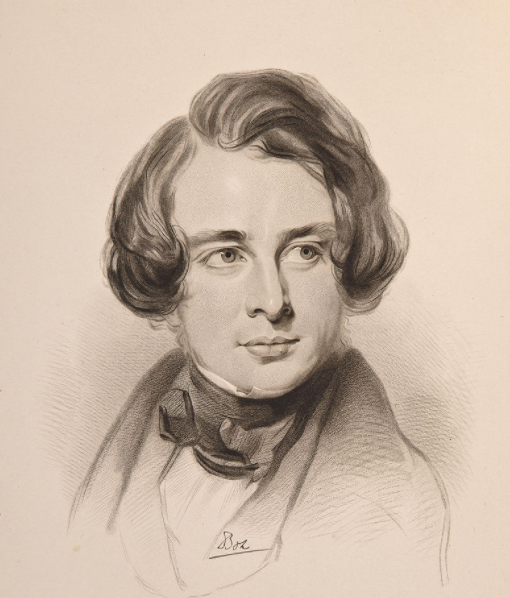Greenock author John Galt (1779-1839) met Marguerite, Countess of Blessington through Lord Byron. Galt had met Byron on his travels on the continent in 1809 and had written his biography - The Life of Lord Byron. Galt often attended the salon in the London home of the Blessingtons along with many literary figures of the day. Galt and Marguerite became friends and kept up a correspondence that lasted until his death in Greenock in 1839. But who was Marguerite, Countess Blessington whom Galt once referred to as “the most gorgeous Lady Blessington”? (As she was referred to by admirer Dr Samuel Parr.)
 |
| Countess Blessington |
Marguerite was born Margaret (Sally) Power in Clonmel, Tipperary in Ireland in 1789. Her father was a hard living man of the minor local gentry. He kept company with many of the local army officers and was a drunk and often in debt. He had no scruples in accepting money in exchange for his daughter. So when Margaret was just 15 she was married off to Captain Maurice Farmer of the 47th Regiment of Foot who was stationed near their home. Three difficult and violent months later Margaret had the courage to leave her husband and return home. A short time later she met another English officer, Captain Thomas Jenkins, who was a very different sort of man. She returned with him to his family home in Hampshire Not much seems to be known about her life there.
It was here that she met Charles John Gardiner, Viscount Mountjoy, later created Earl of Blessington, a widower with four children (two legitimate). He fell in love with Margaret and paid Jenkins off. The couple travelled to London where he set Margaret up in a house in Manchester Square. Fortunately for the couple, Margaret’s husband (Farmer) died in debtors prison in 1818 leaving Margaret free to marry. She became Countess Blessington and changed her name to Marguerite with a home in St James Square. It was here that the couple lavishly entertained and where she met John Galt.
 |
| John Galt by Count D'Orsay |
Count Blessington’s owned the Mountjoy Forest Estate in County Tyrone, but Marguerite had no wish to return to Ireland. In fact Galt wrote to her on this subject from Liverpool in July 1822. He agrees with her decision and writes:
“… I address you more as an intellect than a lady, and the interest I take in all that concerns my friends must be accepted as the only excuse I can offer for the freedom.”
In 1822 the Blessingtons set off on an expensively lavish grand
tour of France and Italy. Part of their
entourage was a private chef and mobile kitchen. They were joined by the young, handsome
Frenchman, Alfred Count D’Orsay who had been a great favourite with London
society and reputed to be Marguerite’s lover.
(Some speculated that he was the Count’s lover). At Genoa they met with Lord Byron who seemed
to have taken to Marguerite. (She would
later, like Galt, write a book about him.)
However, others she met thought her “vulgar”. They travelled widely and also spent time in
Naples and Florence. Questions were
asked about d’Orsay’s inclusion with the party and it was explained that he was
to marry Count Blessington’s fifteen year old daughter, Harriet Gardiner, whom
he had never met. However, a large
financial settlement eased the bargain, and the couple were married in Naples
in 1827 thus d’Orsay became Blessington’s heir as he had no sons. The travellers moved to Paris where Count
Blessington died of a stroke in 1829.
Marguerite returned to London but her reputation had preceded her, but she managed to recreate her “salon” attracting many famous persons of the day although she was largely shunned by society ladies. In 1835, already unwell, Galt wrote to her from Greenock:
“I shall soon have occasion to send your Ladyship my little work, which is now making up, for my unfortunate restlessness of mind must have something to do, and I can do nothing that is not sedentary, for to add to the trouble of entire lameness, my memory is often very ineffectual, and things of the nature of amusements more than business must, I fear, even with convalescence, be my occupation for the remainder of my life, if able to attend to them.” Galt died in 1839.
 |
| Count D'Orsay |
D’Orsay and Harriet’s marriage broke down in 1838 and, despite a large settlement payment from Harriet (in order that he would have no claim on the Blessington estate), financial crisis loomed. D’Orsay continued to live with Marguerite at Semour Place and later at Gore House (now the site of the Albert Hall) in London. Many of the literary giants of the time were attracted to her home.
 |
| Charles Dickens 1842 |
Despite financial troubles, Marguerite was a resilient woman, and she started writing as a means of earning badly needed money. She wrote novels and contributed to many of the monthly magazines which were popular at the time. She contributed to Charles Dickens, Daily News.
 |
| Daily News 1847 |
“Her celebrity and vogue among men of talent arose primarily from her beauty, wit, conversational powers, and highly cultivated mind. But had she possessed no personal attractions … her published works alone would have attracted admirers around her, and would have established her claim to be ranked with the most noteworthy of her contemporaries.”
 |
| Tomb of Lady Blessington and Count D'Orsay, Chambourcy, France |
D’Orsay took to painting portraits. He died in 1852 and was interred alongside Marguerite in Chambourcy in the grey stone tomb he designed for her.
Marguerite was a strong woman who seemed not to care about what society thought of her. She forged her own path through society and won the admiration of not just John Galt but many of the important people of her day.

.JPG)
.JPG)
.JPG)
.JPG)
.JPG)
.JPG)



.JPG)

.JPG)
.JPG)















